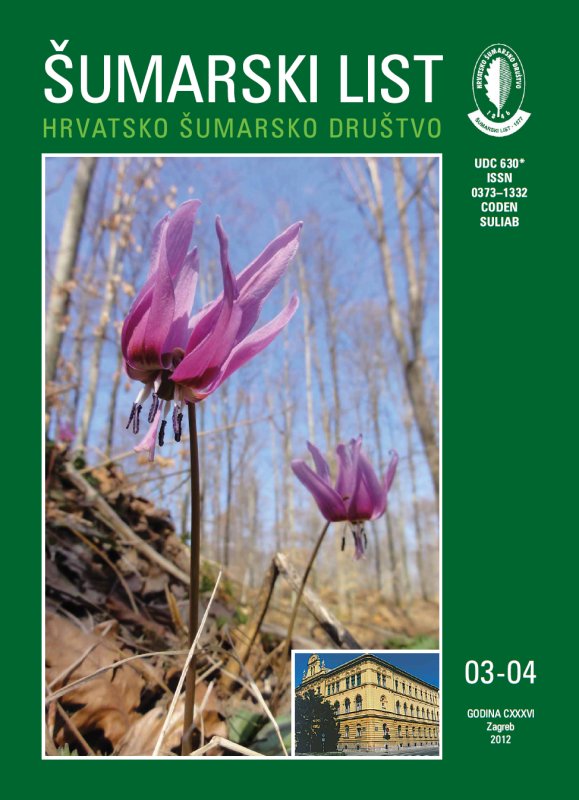
broj: 3-4/2012
pdf (7,00 MB) |
|
||||||||||||||
| RIJEČ UREDNIŠTVA | ||
| Uredništvo | ||
| CROATIAN FORESTRY AT THE CROSSROADS pdf HR EN | 117 | |
| IZVORNI ZNANSTVENI ČLANCI | ||
| Maja Jurc | UDK 630*453 (Phyllonorycter issikii) (001) | |
| The Lime leafminer (Phyllonorycter issikii) in Slovenia pdf HR EN | 119 | |
| Ivan BALENOVIĆ, Ante SELETKOVIĆ, Renata PERNAR, Maša Zorana OSTROGOVIĆ, Anamarija JAZBEC | UDK 630*521+522+531 (001) | |
| Regression models of dbh estimation for photogrammetric maesurement pdf HR EN | 129 | |
| Summary: Since it is impossible to measure diameters at breast height (dbh) directly from aerial photographs, existence of reliable dbh estimation models is crucial for the application of photogrammetric method in forest stands measurements. Research of relationships and creation of mathematic models for correlations between diameter at breast height and tree variables measured on aerial photographs (crown diameter, tree height, tree number etc.) was therefore the object of numerous scientific studies.
Main goal of this paper was to create the regression models for main tree species (Sessile oak, Common beech, European hornbeam and Black alder) dbh estimation in "Donja Kupčina–Pisarovina" forest management unit of uneven-aged, privately owned, forests located at hilly regions (Figure 1). These models would serve as a prerequisite for the application of photogrammetric method in forest stands measurements, by using contemporary tools and digital photogrammetry techniques. Based on the former studies, and keeping in mind the heterogeneous structure of the researched stands, in dbh modelling were used two independent variables. First model (dM1) used crown diameter and tree height, while second model (dM2) used crown projection area and tree height for the above mentioned variables. Field measurements of stands’ structural elements (diameter at breast height, crown diameter and tree height (Figure 2)) needed for creating regression models was conducted on the sample of 383 trees in total (103 Sessile oak trees, 103 Common beech trees, 127 European hornbeam trees and 50 Black alder trees), distributed through 6 chosen compartments (16 to 21) at "Donja Kupčina–Pisarovina" forest management unit (Figure 1). Conducted partial correlation confirmed the statistical significance of all independent variables (crown diameter, crown area and tree height) planned for model creation (Table 1). Multiple regression analysis confirmed the statistical significance of all created models – both model types (dM1 – Table 2 and dM2 – Table 3) and all tree species (Sessile oak, Common beech, European hornbeam and Black alder). Modelling results have shown that independent variables crown diameter and tree height from the first model (dM – Table 2), as well as the crown projection area and tree height from the second model (dM – Table 3) explain the variability of diameter at breast height with high values of determination coefficients (R2 > 0,76). By comparing the results based on tree species between different model types, it was determined that the first model for Sessile oak and Common beech shows better results – 4% higher values of determination coefficient, and lesser error values in dbh estimation, expressed through root mean square error (RMSE), were obtained. For European hornbeam and Black alder both models produced almost identical results regarding R2 and RMSE values. Since crown diameter and tree height variables in Common beech model (dM1) increase the explained dbh variability by only 3%, using the simpler model with crown diameter as the only independent variable is recommended for estimating Common beech diameter at breast height, especially if tree height is not measured during the photogrammetric measuring. Based on the obtained results and regression analysis parameters for each individual model (Table 2 and 3), as well as the results from graphic (Figure 3 to 5) and analytic (Kolmogorov-Smirnov test) testing of each individual model, we can conclude that created regression models can be used for dbh estimation in "Donja Kupčina–Pisarovina" forest management unit of uneven-aged, privately owned forests located at hilly regions, and also in forest stands with similar characteristics. In order to confirm the possibility of practical application for created regression models it is necessary to conduct a photogrammetric measurement of forest stands in "Donja Kupčina–Pisarovina" forest management unit, and to compare the obtained results and the costs of its application to terestrial measurements. | ||
| Győző F. HORVÁTH, Dávid SCHÄFFER, Ákos POGÁNY, Dániel TÓTH | UDK 630*451+411 (001) | |
| Spatial distribution of small mammal populations in Drava floodplain forest pdf HR EN | 141 | |
| Tzvetan ZLATANOV, Ivaylo VELICHKOV, Georgi HINKOV, Margarita GEORGIEVA, Olafur EGGERTSSON, Saevar HREIDARSSON, Magdalena ZLATANOVA, Georgi GEORGIEV | UDK 630*561+114 (Castanea sativa Mill.) (001) | |
| Site index curves for European Chestnut (Castanea sativa Mill.) in Belasitsa mountain pdf HR EN | 153 | |
| Bojana KLAŠNJA, Saša ORLOVIĆ, Zoran GALIĆ | UDK 630*232:232.4+238 (001) | |
| Energy potential of poplar plantations in two spacings and two rotations pdf HR EN | 161 | |
| PREGLEDNI ČLANCI | ||
| Igor ANIĆ, Šime MEŠTROVIĆ, Slavko MATIĆ | UDK 630*902 | |
| Important events in the history of forestry in Croatia pdf HR EN | 169 | |


